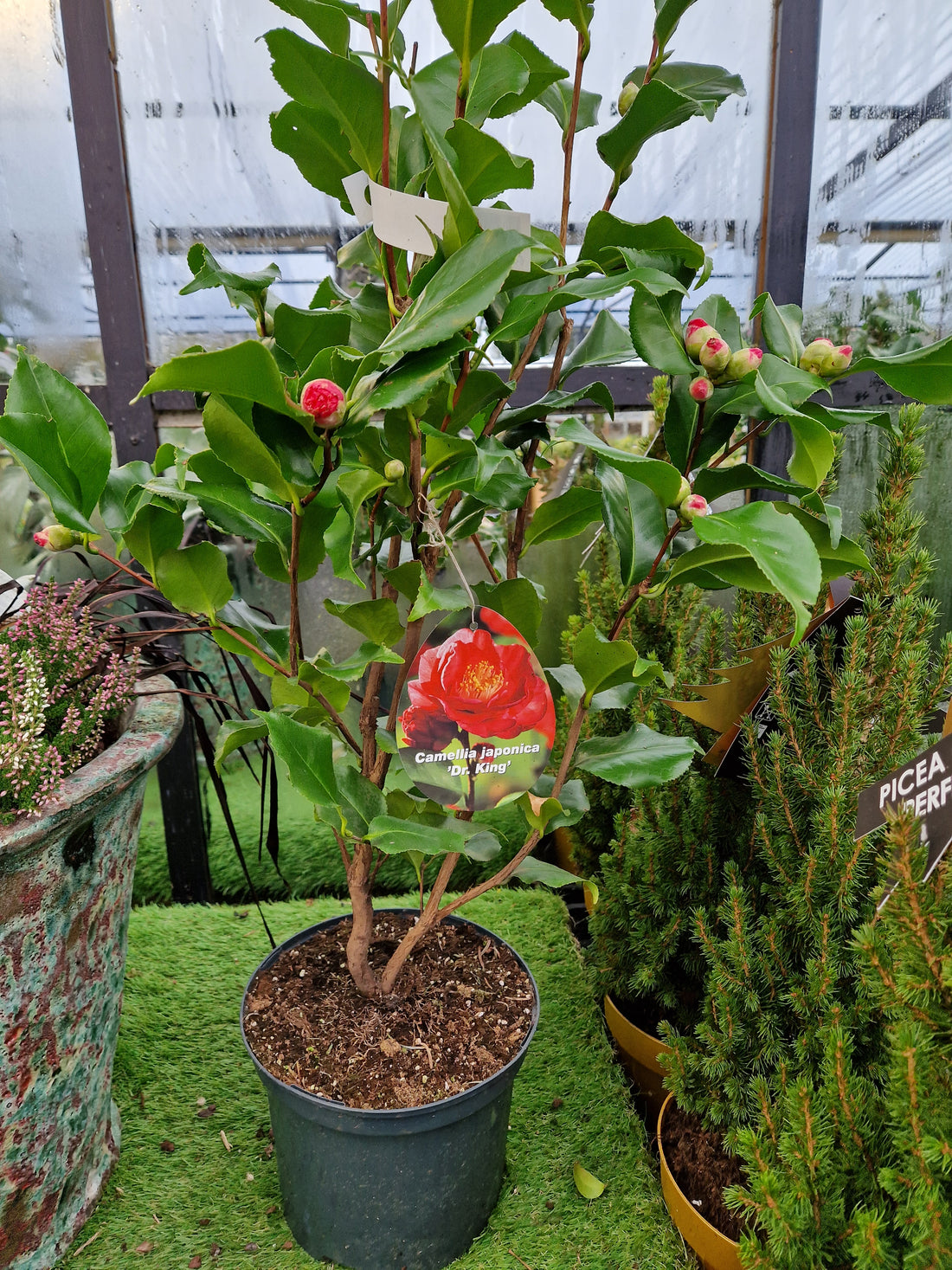Camellias are an attractive evergreen range of shrubs that produce beautiful large flowers during late Winter and early Spring. Camellias were cultivated in the gardens of China and Japan for centuries before they were seen in Europe. The leaves and buds that are used for making tea come from a variety of Camellia - Camellia Sinensis. Other uses include medicinal anti-inflammatory, hair care products and a type of cooking oil used by millions of people in parts of China. In this part of the world we are happy to grow them for their ornamental value, particularly the flowers, which are sometimes mistaken for Roses, and come in a range of colours from shades of white, pink and red - some with double flowers and some with single flowers and they offer a great show of colour for that time when you might not have lots of shrubs in flower. They also have the advantage of being evergreen and their glossy green foliage looks good all year round. Whichever variety of Camellia you choose, you’ll need to get the soil conditions right. Camellias need to grow in acidic soil, soil with a low pH level. If you don't have this type of soil in your garden, and many of us don’t, you can use ericaceous compost and some leaf mould if you have some. There are loads of varieties that are happy growing in pots or containers using ericaceous (or acidic) compost. This is widely available in garden centres and is no more expensive than regular multi purpose compost, it just has a more acidic makeup. When choosing a location Camellias prefer an area that is in dappled shade or even partial shade, they are a woodland plant and aren’t too happy in a very sunny position. Direct sunlight in the morning can dry out the flower buds too quickly as they are developing so somewhere that gets morning shade is best suited to their needs and choose a spot that’s sheltered from strong winds - somewhere not too exposed.
When you are ready for planting and you plan on using a pot or container, which should be at least 12 or 14 inches, first give your Camellia a good watering in its original pot, preferably with rain water if you can, giving the roots a good soaking and allow it to drain. Make sure there are plenty of holes in the bottom of your pot and add stones or broken crocker to improve drainage. Fill your pot about two-thirds full with ericaceous compost, leaving enough room for your Camellia.
Position the plant in the middle of the pot with the top of its root ball about 2 inches below the rim of the pot. Fill in around the roots with your compost and push down with your fingers. Water well and allow it to drain. Camellias are somewhat slow growing so shouldn’t need to be re-potted too soon - but keep an eye on them and don’t allow them to become pot bound. When you’re watering them use rainwater if you can - this is particularly important in areas where there is lots of lime in the water. It's important to keep camellias well watered in Summer, between July and September, as this is when next year's flower buds are formed so use tap water if needed but keep them moist late Summer early Autumn. They aren’t a particularly hungry plant but an ericaceous feed - either liquid or granules will keep them healthy and maintain a glossy green leaf, but avoid feeding them too much in Summer. A good bark mulch or a mulch of compost is beneficial also. They are a hardy plant but severe frost or snow can damage the leaves so perhaps wrapping them in some garden fleece during prolonged or very cold weather or if it’s practical to bring them inside for a short bit during very cold spells.
Some great varieties to look out for are; Camellia Japonica Dr. King, large, semi-double, rose-red flowers with a gold centre in Spring between March and May. Camellia Lady Campbell - a hardy and vigorous Camellia with bright red double flowers and compact growing to just 2.5 metres making it a good choice for gardens of all sizes and growing in containers. Camellia Mary Williams is an early flowering camellia with large single pink flowers. It's perfect for woodland gardens and containers. With camellias there is very little maintenance - no need to prune them - you can deadhead faded flowers to keep them tidy - and as mentioned earlier don’t allow them to dry out especially in late Summer. They make a wonderful gift for any occasion particularly from now to late Spring when they are either in bud or flower and looking really good
A few jobs for the week ahead;
- After all those strong winds check stakes and tree ties to make sure they haven’t shifted too much and make a plan to realign them where appropriate - make sure you prioritise your own safety before taking on any gardening jobs
- Onion sets and shallots and garlic are all available to buy at this time of year - pick up your favorite varieties and even try a new type
- With Spring soon approaching you can dig some farmyard manure into beds to condition and enrich your soil - they’re on offer at the moment buy 2 get 3rd free
- Plant up some potted bulbs if you missed out on planting bulbs in the Autumn - lots of snowdrops, crocus, daffs and tulips available in small pots - ideal for planting now
- You can use a greenhouse fumigator or smoke bomb to clean out your glass house or polytunnel from any unwelcome insect pests before you start planting up for the season - easy to use each fumigator will cover around 8m2 up to 120m2 depending on what you need to get rid of

